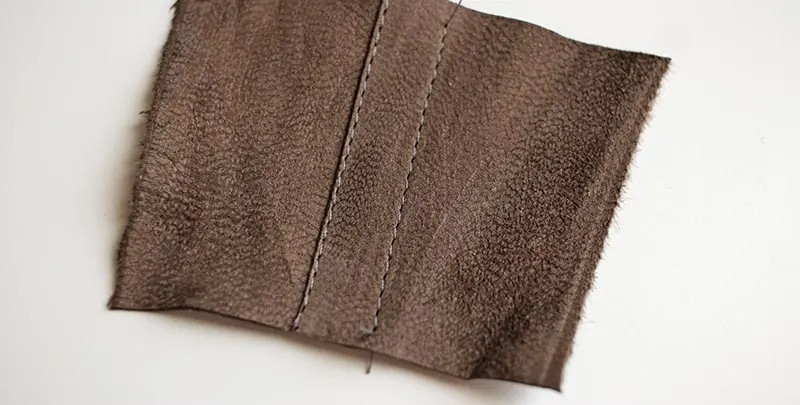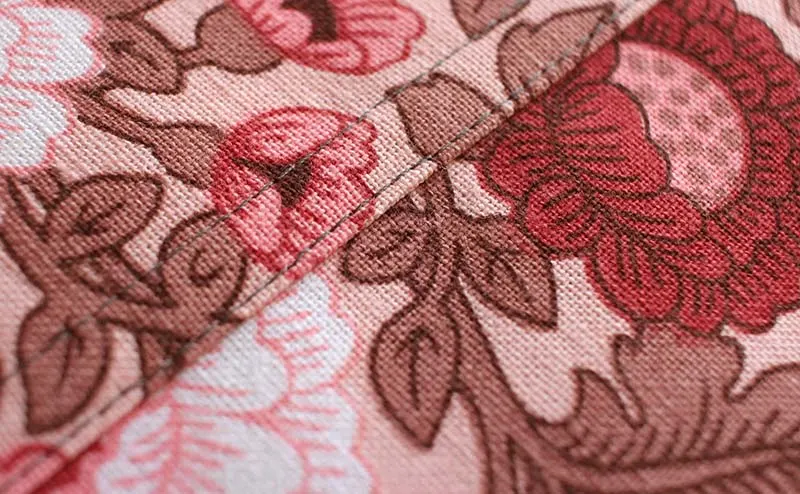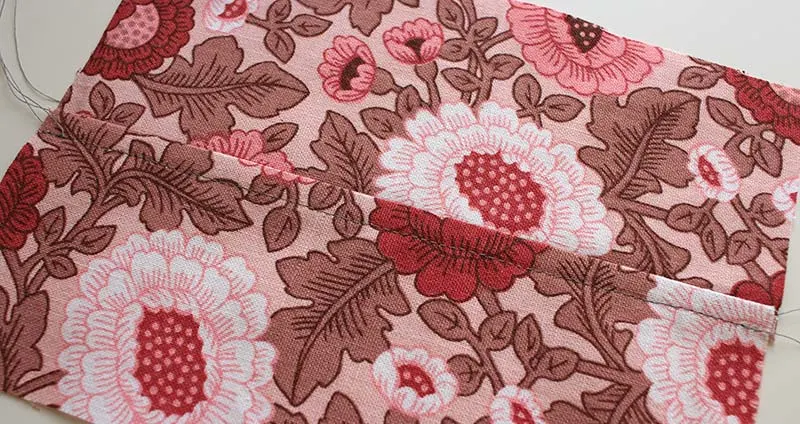Would you like to learn how to sew a seam? In this post we’ll take a look at the different types of seams open to you when you start sewing your own clothes, and you’ll learn how to sew a seam too!
Understanding the different types of seams, and how to sew them, is important because they are a key part of sewing clothes and will really affect how your final garment looks!
If you’re completely new to sewing, you can pop here to learn more about the history of sewing and essential sewing tools first!
And if you prefer video, scroll to the bottom of this article for my video showing the different seam finishes and when each would be used!

Some of the links in this article are affiliate links. This means that I may receive a fee at no extra cost to you if you purchase a recommended product.
What Is A Seam In Sewing?
An actual seam definition is:
The line where two or more layers of fabric are held together by stitches.
Wikipedia
But in reality, a seam is created when different pieces of cloth are sewn together, usually using a machine or by hand sewing. That said seams can also be glued or fused together depending on the fabric being used – take lather as an example, it is often ‘cemented’ together!
Seam Finishes: How Are Seams Used?
As well as having the function of joining two pieces of fabric together, seams can also be used as a decorative feature and as a way to finish a garment off.
If we consider jeans as an example, the seam used on both the inside of the leg and the back yoke (this is the bit above the back patch pockets which is attached to the waistband) is called a welt, and it provides both function and style.
The function part is the reinforcement of the seam which gives it strength against a lot of wear and tear – denim was originally a workwear fabric after all ya know! The style aspect of the welt seam is the different colour thread used for top stitching, as well as the width of the seam: wide or narrow?
Changing the topstitch thread colour and / or the width of the flat felled seam will have a strong visual impact on the sewn garment.
How Hard Is It To Sew Seams?

Sewing seams neatly is not as hard as you may think. It takes practice but you will get there – promise! The most simple and easiest sewing seam to start with is what is know as the ‘open seam‘ or ‘plain seam’.
To create a plain seam seam you lay one piece of fabric on top of another with their ‘right sides’ facing each other. You sew a stitch line along the length, leaving an allowance on the edge. Standard in the UK is 1cm, and in the US it is ⅝ inch.
Slightly more complicated are ‘French Seams‘ and curved ‘Fell Seams‘ – these are enclosed seams. A French seam uses two stitch lines, so that the seam allowance is captured inside. It’s a tidy seam, and great seam finish choice for sheer or delicate fabrics.
A run and fell seam is primarily used on shirts. It also neatens things up so that seam allowances are not fraying and visible. This seam is a little tricky on a straight seam, but on a curve? Wowsers… 😉
If you’re worried about how hard it is to sew seams, fear not! This types of seams guide with the short seam tutorials will help, and I’ve linked each type of seam to the relevant sewing tutorial too!
How Do You Know Which Seam To Use?
If you’re using a commercial sewing pattern, the instructions provided will usually tell you which type of seam to use and how much seam allowance to have. Once you’ve had a bit of practice, it’s fun to change this up and experiment for yourself.
The only major no-no would be trying sew an enclosed seam on a bulky or heavy weight fabric. You may get it to seam, but the weight of the fabric used would make it look clunky and unattractive!
Other Ways To Create Seams
Sewing seams is not the only way to put two pieces of fabric together.
Cement Or Glue
If you’re using leather, you can glue or cement seams by laying the wrong side of one piece on top of the right side of another. If the glue or cement isn’t particularly strong, or not designed to work with leather, you’d probably want to reinforce the seam with a line or two of stitching though.
Double Sided Fusing

You could also use a double sided fusible to ‘stick’ two fabrics together. When I was interning at Roland Mouret, we fused two layers of fabric together to make the garments reversible. They called it arrignée – which means spiders web in French apparently! 😮
Using Hardware Elements
More decorative ways to make a seam would be to use hardware such as rivets, grommets and eyelets. Just as you placed the two pieces of leather on top of each other with glue, you can do the same with metal wear.
If you feel like testing out your new seams on clothing patterns, check out this post highlighting 5 easy sewing patterns for sewing beginners or this post about sewing books with patterns! <– both links will open in a separate window for you! 🙂
Different Types Of Seams

There are quite a few seams to choose from when sewing your own clothes, but your first decision would be to decide on an enclosed seam or not.
Enclosed Seams
Enclosed seams are seams that keep all the seam allowance hidden within the seam finish. An enclosed seam usually needs two stitch lines as a minimum.
Non-Enclosed Seams

This should be clear based upon the heading, but non-enclosed seams leave the seam allowance visible. This means that the edge of the fabric needs to be finished to prevent it fraying.
- Open seam
- Lapped seam
- Welt seam
- Piped seam
How To Sew A Seam
Right, lets jump in to each of the seams, and how to sew them, which really is just learning how to sew two pieces of fabric together – not scary at all right? If you have any questions, do use the comments at the bottom of this post to let me know!
Open seam
If you’d like to learn to sew an open seam with a step by step photo tutorial, pop to this open seams article! It leaves raw edges so you will need to finish the edges of your seam allowance with a serger or a zig zag stitch, to prevent fraying!
- Place one piece of fabric on the table with the right side facing up towards you.
- Place the second piece of fabric on top of this with the wrong side facing up towards you.
- Match up the all the notches (if applicable).
- Take the fabric to the sewing machine, and place under the sewing machine foot so that the edge of the fabric lines up with the 1cm guideline (or the amount you’re using for your seam allowance!).
- Place the presser foot down.
- Turn the needle with your right hand so the needle pokes a little into the fabric.
- Use the back / reverse option to make a few back stitches to secure the start.
- Continue sewing forward, slow and steady. Try not to watch the needle, as your line may go wonky, instead focus your attention on the line in the centre of the sewing foot.
- When you’ve sewn all the way along the stitch line, stop but keep the needle in the fabric.
- Lift the presser foot, turn the fabric 180 degrees so they the seam allowance is on the opposite side, and pop the presser foot right back down again. (You could also just use the reverse stitch button again.)
- Sew 2-3 stitches, just to secure the end of seam line.
- Press both sides of the seam allowance open


French Seam
A French seam is a delicate thing, to be used on sheer or fine fabrics only, as anything heavy would be too bulky! This is a basic overview starting with a 1cm seam allowance, but I have a more in-depth French seam sewing tutorial here. And if you’re wanting to sew a curved French seam in a sheer fabric, you’ll want this curved French seam tutorial! And if a French seam sounds too tricky, try this mock French seam tutorial instead!
- Place the wrong sides of the fabric pieces together, and sew as straight and smooth as possible.
- Press the stitched line.
- Trim the seam allowance down to 4mm.
- Press this seam allowance to one side.
- Place the right sides of the fabric together and press.
- Now sew along the seamline with a 6mm seam allowance.
- Press and finish.
This should leave you with a beautifully crafted French seam and no threads peeking through. Voila!


Welt Seam
As mentioned earlier, a welt seam is used in denim as well as workwear and outerwear. It’s an easy seam to construct.
Sewn just like an open seam, but with a bigger seam allowance, the seam is opened out and the allowance pressed to one side before being stitched down. It is a less bulky version of a felled seam on denim, and is not an enclosed seam! Do pop to my post ‘Welt Seam Tutorial‘ if you need a photo tutorial!
- Place right sides of fabric together.
- Sew a 1cm seam allowance down the length of fabric.
- Press.
- If you have one, overlock (or serge) the edge of the allowance, being careful not to trim the fabric with the blades!
- If you don’t have a serger / overlocker, you can use the zigzag stitch on your machine.
- Press the allowance to one side.
- On the right side, stitch a line parallel to the seam line in order to secure the allowance and strengthen the seam.
I’ll do a further post in the coming months on how to analyse a pair of jeans, so you’re in a position to make your own pair! 🙂
Flat Fell Seam
The fell seam. Hmmm… When I was at uni, I was told to do a ‘running fell seam’ on one of my garments, for the shirt project. Having never encountered such a seam before, I went off and searched my many sewing and pattern making books. Nothing. I explored the uni library – still nothing. In desperation, I asked Google.
Turns out, the running fell / run and fell seam is basically just a flat fell seam, only with the fabric starting from rights sides together! Doh!
For a much more in-depth look at flat-felled seams and run and fell seam, pop to this flat felled seam tutorial!
- Start with a 1.5cm allowance, unless you specifically want a narrower seam finish.
- Place the wrong side of the fabric together, so the right side is facing you.
- Stitch along your 1.5cm allowance.
- Press.
- Trim one side of the allowance to 5mm.
- Press both allowances to one side.
- Fold the larger allowance over the smaller allowance, enclosing it.
- Press.
- Stitch along the edge (this will be the wrong side of the fabric facing you – and also the ‘running’ fell aspect!)
- Turn to the right side of the fabric.
- Edge stitch the seam.
Here’s a flat felled seam…

And here’s a run and fell seam. Can you spot the difference?

I have tutorials on sewing a flat felled seam or a run and fell seam.
Lapped Seam
This seam is usually used on leather, suede and non fray fabrics only. Here’s a fab step by step photo tutorial for sewing a lapped seam!
- One piece of your fabric should have 1cm seam allowance.
- The second piece should have the seam allowance trimmed off.
- Place the second piece (no seam allowance) on top of the first piece allowance 1cm overlap.
- It can be helpful to use a temporary spray glue to hold the pieces together, as pins will leave visible holes.
- Once you are confident that the piece is secure, start stitching your first line close to the overlapping edge.
- You then stitch a second line close to the unseen edge of the under piece.

That’s it folks. The most important thing to remember is pressing your seams with an iron is the key to having a professional finish. Honestly. And the second most important thing? HAVE FUN!!!
Different Seam Finishes Used In Garment Sewing

dorcas
Wednesday 29th of March 2023
Had great time learning about seams, thanks Eve
Eve Tokens
Thursday 30th of March 2023
You're very welcome! :)
Toni Sturrs
Thursday 11th of August 2016
Wow! I didn't know there were so many different types of seams, such a great post. This is really useful!! :)
Eve Tokens
Thursday 11th of August 2016
Thanks for popping by Toni! Am so glad that it has been informative. Let me know if you have any questions!